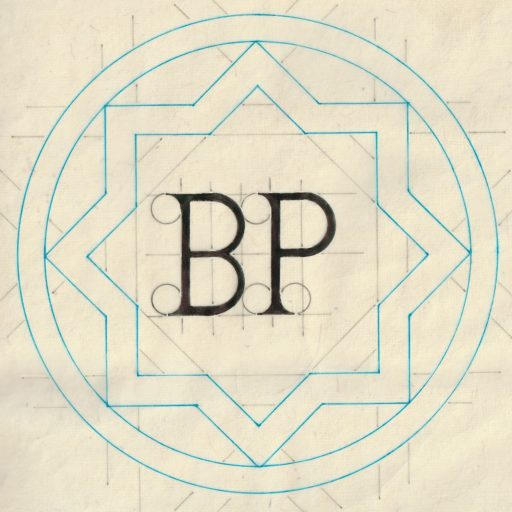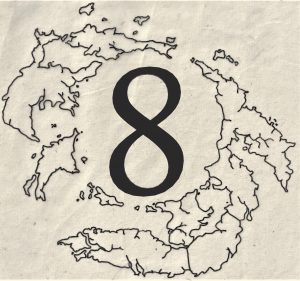
In the previous three articles on world building, I have shared my concept ideas behind the cathedral complex and the cradle gardens, in this article we are going below ground.
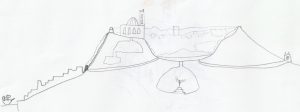
This first image shows an early idea where there is very little below ground. A few chambers have been hollowed out below the cathedral and there is a great cave beneath the lake at the centre of the cradle garden. I had imagined a magical sword floating above a pedestal in this cave beneath the lake, which could only be retrieved by a brave adventurer, in a quest not to dissimilar to King Arthur’s sword in the stone. The little building on the right was a pumphouse which brought water up from another water source to keep the lake filled, whilst the second underground tunnel would be an overflow for the lake, sending water through several fountains in the city. In this early concept I’ve depicted the cathedral with a large central dome, and a single tower at the rear.
My first idea had a few major flaws, one of them been the unbelievable shape, of the supposedly natural bowl of the cradle gardens, and the other, it’s impractical steep sides.
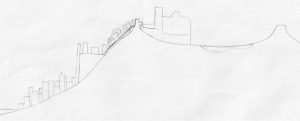
I thought more logically about the geography around the capital of Art, and I came up with the idea of adding an artificial terrace to the city. This would separate the lower city, which was mostly populated by human traders, from the upper city where the homes of the Artens were. By making the natural hollow of the cradle gardens shallow, it provided far more useful space, and I even considered foundations for the cathedral which would provide space for basements.
I was inspired by the Geo Front in the animated series Evangelion, beneath Tokyo Three. I’ve been using the term Geo Front to describe an artificial ground level, rather than a second ground-level beneath the original ground-level, as it was in the animation.
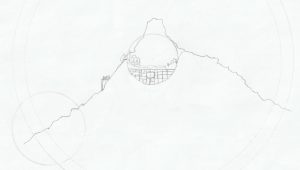
This picture shows the outline of the original mountain peak where Maria’s multi-dimension research facility was based. The inner circle shows the area which was utterly destroyed by the initial dimension implosion. The two large circles show the areas which were ripped from the original dimension, and thrust into the dimension of Gear. The medium-size circle on the right is a result of magical interference, there is a reason why the harbour at Art is so perfectly shaped, it owes its appearance to an explosion. After the arrival of the Artens, which flattened the ancient city of Peeves, the humans thought the Artens to be hostile and tried to destroy them. A number of magic wielder’s worked together to destroy the new island, but they only succeeded in blowing a small hole in one corner.
Whilst this image shows the artificial ground level and a complex of rooms below, it still doesn’t capture my full idea. There are still issues with the steep slope of the city and there is no sense a scale. This diagram would only allow a tiny section of the Arten island to have been brought through the dimensions rather than the vast area which I have described.

After giving more consideration to the layout of the city of Art itself, I came up with the idea of using multiple terraces each one centred on a single street. There are twelve streets that run through the cross-section of the city as shown above, and they divide the city into industrial areas by the docks on the first three levels, housing for human and construction workers on the next three levels, then the main commercial area of the city, which centres around the large eighth street which is home to lots of embassies, offices, and high-end retailers. The final three levels of the city are reserved for Arten residents and a few important human diplomats.
This cross-section only shows the buildings above ground I envisage as much of the city below ground as there is above. With the Arten’s level of technology I imagine there being subterranean rail links which will move vast numbers of people around the city without congesting the streets, along with robotic delivery systems that move packages and daily supplies all across the city.
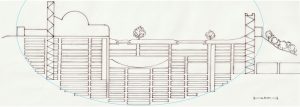
This diagram shows a close-up section through the cradle gardens into the extensive facilities below. Whilst most rooms on the twenty-two levels could be used for almost anything, some rooms were designed with specific purposes. Spanning levels three and four are gymnasiums beneath the lakes that are part of the Arton Academy, the Academy occupies much of the space between levels three and six. Sub floors 1 to 6 beneath the cathedral are occupied by the ecclesiastic element of the Artens, they coordinate humanitarian efforts and the propaganda department. Sub levels 6 to 10 are dedicated to world politic departments, this includes the four-storey central chamber with its curved floor where major policies are debated with representatives from all over the world. Levels 7 to 12 on the right-hand side are dedicated to research and development. This includes 12 large heavy engineering workshops. You can see from the large-scale cross-section that the heavy engineering workshops have access onto a landing pad at the rear of the Cathedral complex. Below level 12 things get a bit complicated various sections are dedicated to the branches of the Arten military, navy and air force. Level 21 and 22 are the smallest and hold the maximum detention centre. I’ve depicted two lift shafts in this cross-section, but there are several more, as well as the emergency staircases, one of which Keyanna used to get into the floors below the cathedral in the first chapter of Beginnings.
I’m no engineer, but I’ve tried to include regular structural supports, but I’m certain many of these rooms would be subdivided into individual office spaces. Between each pair of floors there is a space left for ventilation and service ducts, these are the spaces that Miguel utilises when he has need to sneak around the facility following a hand drawn map, that was handed down from previous badly behaved students.
During the height of the Arton empire these subterranean corridors were high ceilinged, well ventilated, and brightly lit, with artificial windows regularly scattered throughout the facility. Anyone who has read the Harry Potter books would be familiar with the Ministry of Magic, which is all situated underground, yet people act as if it is a normal office block, I borrowed some ideas from that source when I imagined some office workers spending all day underground.
This idea is still one that needs returning to the drawing board for some fine tuning, and talking about drawing boards, in the next article I’m going to be sharing my early mapmaking ideas, failures and successes (mostly the failures).
